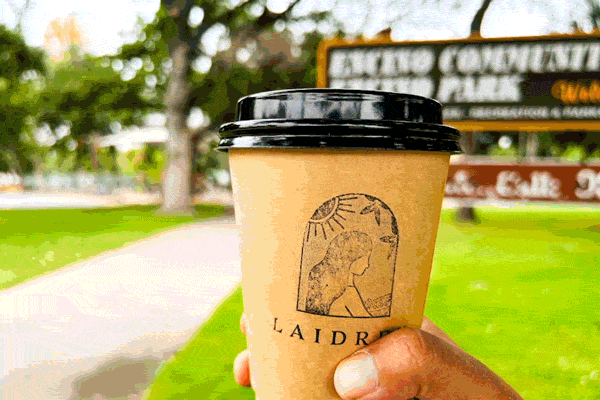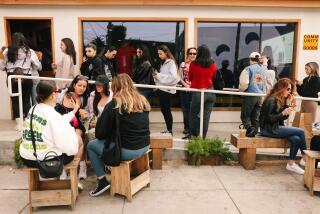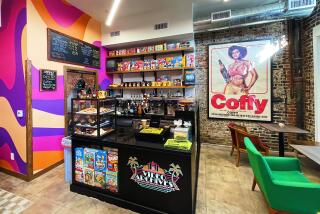A Stimulating Look at Where Coffee Has Bean : History: A 100-item exhibit at the Fullerton Museum Center hopes to perk interest in the brew’s social, political and economic impact globally.
- Share via
FULLERTON — A quiz for java junkies:
A) What did 17th-Century Pope Clement VIII do after his first taste of coffee?
B) Where and when did the world’s first coffeehouse open?
C) What’s the meaning of the Arabic word qahwa , from which the word coffee was derived?
Stumped? Then drain that cup and visit the Fullerton Museum Center, where “From Dancing Goats to Voltaire’s Notes: The History, Geography and Technology of Coffee” opens today and runs through Aug. 27. The exhibit’s got the answers to those questions plus a lot more information about mud. (But if you just can’t wait: A) The Pope baptized the beverage, according to a widely respected coffee authority; B) In Constantinople in 1475; C) “That which prevents sleep.”)
“It’s a fascinating topic,” said Lynn La Bate, the center’s exhibition administrator and coffee-show curator. “If I had had any idea it would be so interesting, I would have had the exhibit up longer.”
Granted, La Bate’s a coffee drinker. But the show’s examination of coffee’s social, political and economic impact around the world through time should even have something to say to decaf fans.
Indeed, the humble bean may have played a role in the development of Western civilization, La Bate said. It’s rumored that Voltaire helped to define the Enlightenment while drinking 40 cups a day in a French coffeehouse where caffeine-fortified intellectuals gathered. His high-strung cronies included philosophers Jean Jacques Rousseau and Denis Diderot, the man credited with developing the first encyclopedia.
“In the 1700s and 1800s, it was in European coffeehouses where the great ideas of the day were discussed,” she said. “Coffee influenced our lives in ways we don’t even think about.”
The 100-piece exhibit includes an array of old and new coffee grinders, brewers and roasters. There’s a bulbous tin pot made in France in 1750, a seven-cup, aluminum percolator by Comet that should make baby boomers reminisce and “The Big Pot,” a pot-shaped grinder used by the Navy in World War II that shared technology with minesweepers.
“People have been trying for centuries to make a cup of coffee that tastes as good as it smells,” La Bate said recently while walking through the show.
Historical and contemporary photographs, a video and delightfully nostalgic 1930s Beech-Nut coffee tins round out the display items, many of which were loaned by Orange County coffee merchants whose names appear on exhibit labels and on some of the items themselves.
Lenders include Martin Diedrich, president and partner of Diedrich’s Coffee shops, and eight-year museum center board member Paul Berkman, who owns Rutabegorz restaurants in Fullerton, Tustin and Irvine. The Irvine location is where Berkman displays his pot collection and offers the widest range of gourmet coffees of the three.
Berkman, who came up with the idea for the show, said his motive had nothing to do with sales promotion. He’s long been fascinated by the history and culture of coffee, he said, having amassed a 100-piece coffee pot collection over the past 25 years.
“Nobody has ever tackled a coffee exhibit before,” he said.
Visitors will learn that, according to legend, Kaldi, a goatherd in Abyssinia (modern Ethiopia), discovered coffee more than 1,000 years ago when his goats frolicked late into the night after eating a wild coffee plant’s red berries.
Coffee was first widely cultivated in Arabia, spread throughout the Middle East during the 1500s, then throughout Europe, where it thrived during the 17th and 18th centuries.
Pope Clement VIII helped its European popularity, said La Bate, who based much of her research on “All About Coffee” by William H. Ukers, which she called “the definitive source.” The Ottoman Empire had long held a monopoly on the lucrative beverage--trading only roasted beans so the plant couldn’t be reproduced--but the pontiff blessed the drink and made it a “Christian beverage.”
“He said it was too good for the ‘infidels’ to have” exclusively, La Bate said.
Coffee came to the Americas through the chicanery of a French infantry colonial, Capt. Gabriel Mathieu de Clieu. The captain had his French paramour steal three coffee plants from King Louis XIV; then he set sail for the Caribbean island of Martinique. Two of the plants died at sea, but de Clieu saved the third by carefully rationing his drinking water.
“Every coffee plant in the Americas,” La Bate said, “is a descendant of the one plant De Clieu brought to Martinique--and that accounts for about 90% of the world’s coffee.”
Other facts center on production, La Bate said. Big American factories that could roast and mass produce the brew spelled the demise of the street-corner roaster in the late 1800s. A shipping crate on view bears the brand name Arbuckle’s, one such company.
Modern coffee production still relies on humans, however, from the farm workers who harvest the crops to the “master roasters” who decide when the automated roasting process is complete.
“If a roaster is even a few seconds off on his timing,” La Bate said, “the beans are ruined. We think of ourselves as so technologically advanced, but it’s really human skill and sensibility and judgment that makes coffee what it is.”
“From Dancing Goats to Voltaire’s Notes” doesn’t delve into the role coffee has played in labor relations, environmental issues, industrial ethics or imperialism and colonialism. But the show doesn’t attempt to be a definitive expose, La Bate said.
“If there’s an area that interests people further, they can do more research,” La Bate said. “We hope to stimulate people’s interest.”
Just in case the exhibit doesn’t do the trick, she quipped, the coffee the center is selling in the lobby throughout the show’s run should.
* “From Dancing Goats to Voltaire’s Notes: The History, Geography and Technology of Coffee” opens today at Fullerton Museum Center, 301 N. Pomona Ave., Fullerton. Hours are noon-4 p.m., Wednesday, Friday, Saturday and Sunday; noon-8 p.m., Thursday. Through Aug. 27. $2 to $3, free from 6 to 8 p.m. on Thursday. (714) 738-6545.
More to Read
Eat your way across L.A.
Get our weekly Tasting Notes newsletter for reviews, news and more.
You may occasionally receive promotional content from the Los Angeles Times.










